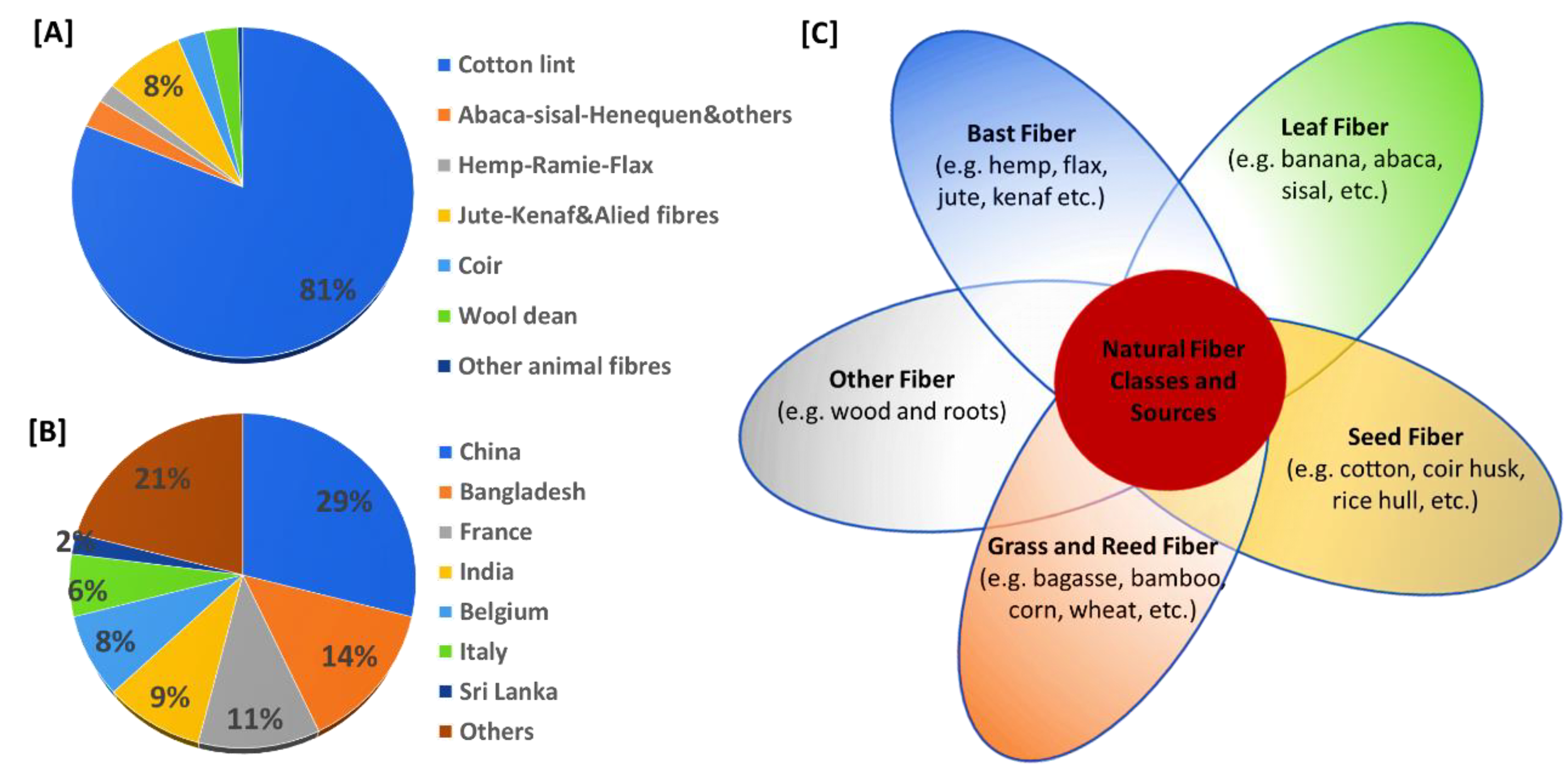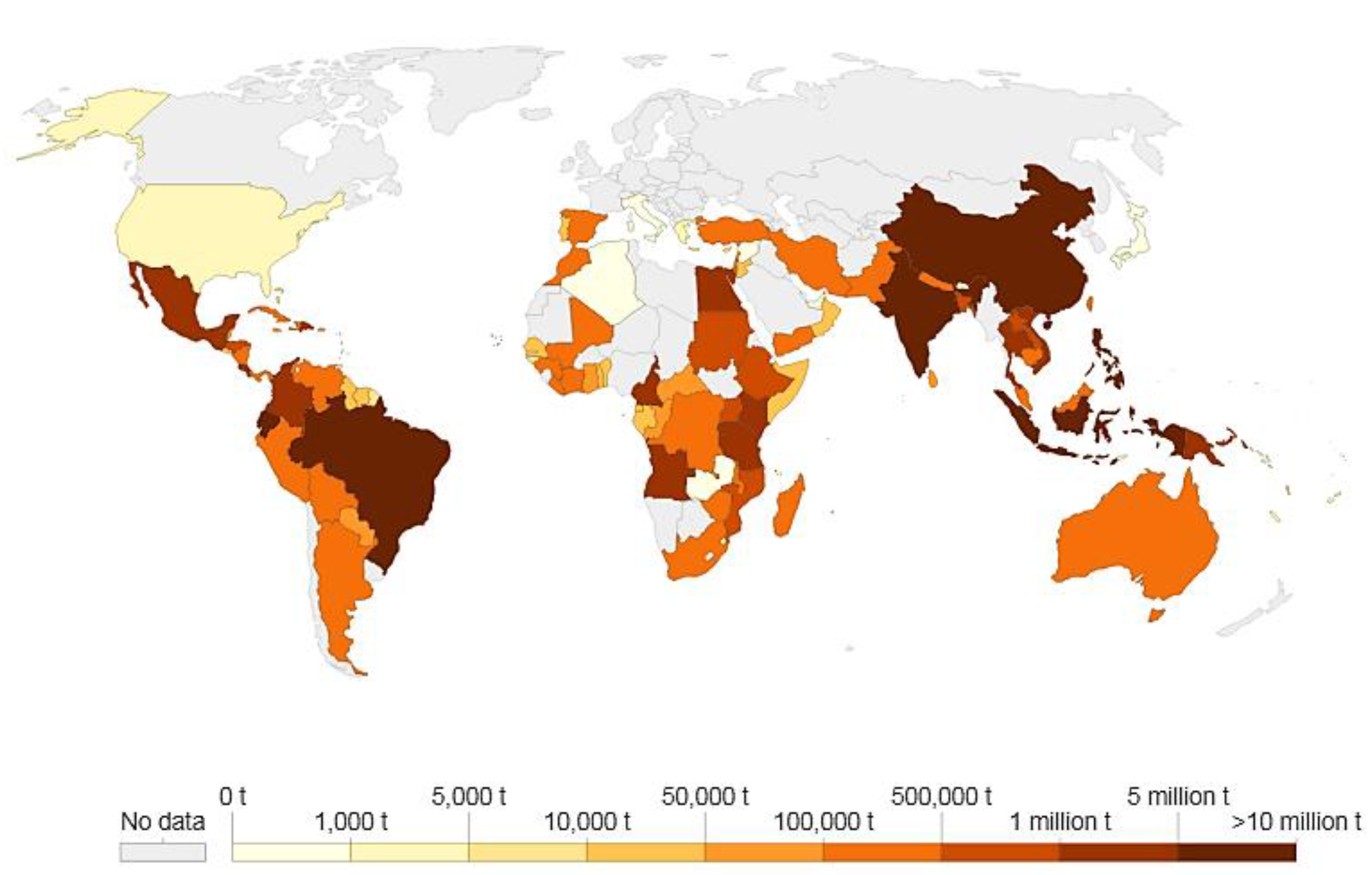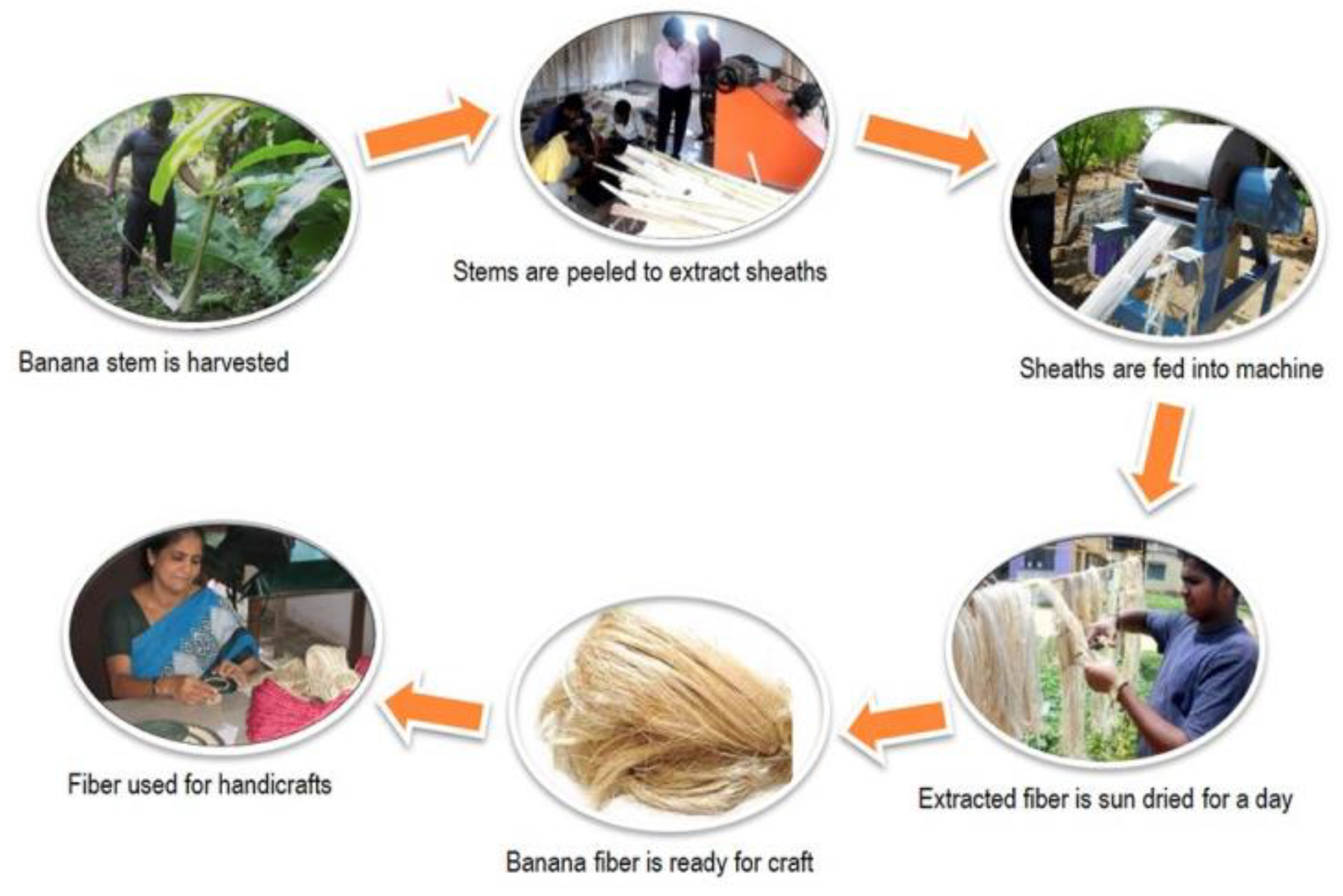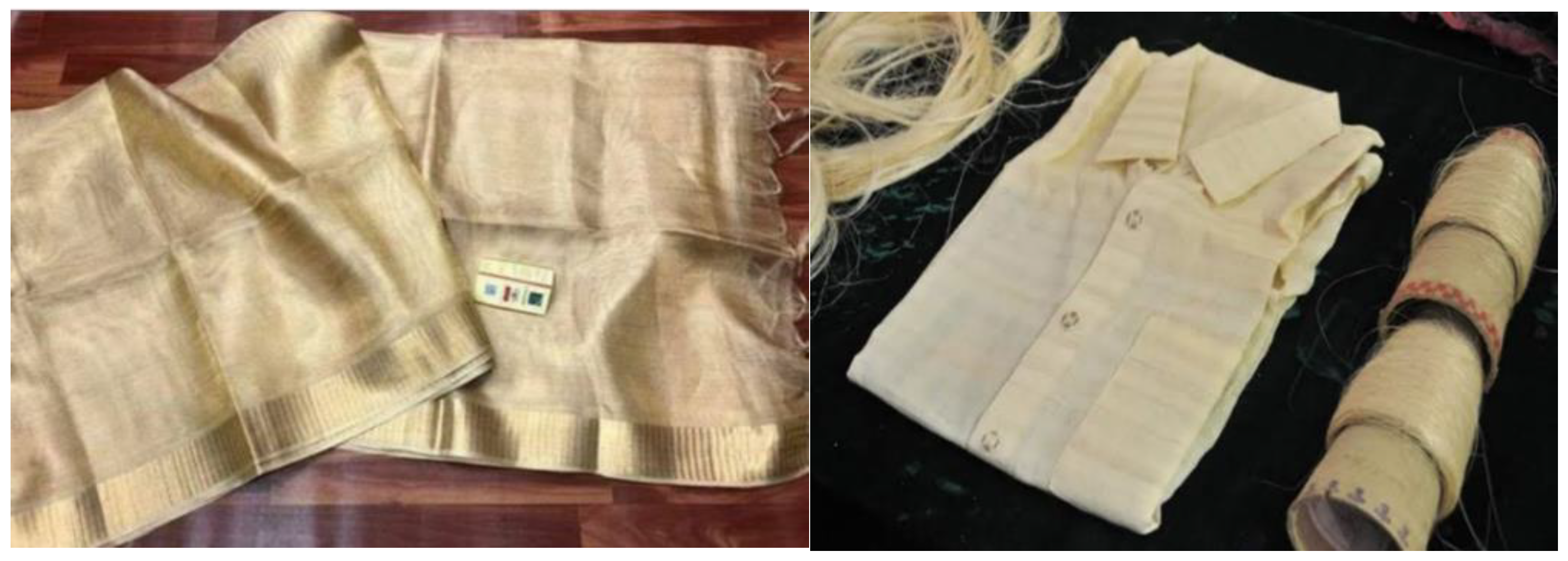Agriculture Waste Biomass Repurposed into Natural Fibers: A Circular Bioeconomy Perspective
Abstract
:1. Introduction
1.1. Natural Fibers and Composition
1.2. Fiber Extraction
| Fiber Class | Types of Fiber | Volume (Tonnes) | Dimension | Chemical Composition | Physical and Mechanical Properties | |||||||
|---|---|---|---|---|---|---|---|---|---|---|---|---|
| Fiber Length (mm) | Width Fiber (μm) | Fibril Angle (Degrees) | Cellulose (%) | Hemicellulose (%) | Lignin (%) | Density (g m−2) | Tensiles Trength (MPa) | Young’s Modulus (GPa) | Elongation at Break (%) | |||
| Bast | Flax | 190,000 | 0.20–1.40 | 0.04–0.62 | 6–10 | 69.22–71.65 | 18.31–18.69 | 3.05–2.56 | 1.25–1.55 | 500–900 | 50–70 | 2.70–3.6 |
| Jute | 2,700,000 | 3.00–3.50 | 60.00–110 | 7–9 | 69.21–72.35 | 12.55–13.65 | 12.67–13.21 | 1.3–1.45 | 300–700 | 20–50 | 1.69–1.83 | |
| Kenaf | 230,000 | 0.66–0.82 | 17.70–26.70 | 5–10 | 37.50–63.00 | 15.10–21.40 | 18.00–24.30 | 0.15–0.55 | 295–955 | 23.1–27.1 | 1.56–1.78 | |
| Leaf | Sisal | 247,000 | 0.85–1.00 | 100–300 | 10–25 | 43.85–56.63 | 21.12–24.53 | 7.21–9.20 | 1.45–1.5 | 300–500 | 10–30 | 4.10–4.3 |
| Abaca | 78,000 | 2.00–4.00 | 150–260 | 6–7 | 69.23–70.64 | 21.22–21.97 | 5.15–5.87 | 1.42–1.65 | 879–980 | 38–45 | 9–11 | |
| Pineapple | - | 3.00–9.00 | 20.00–80.00 | 10–15 | 70.55–82.31 | 18.73–21.90 | 5.35–12.33 | 1.25–1.60 | 166–175 | 5.51–6.76 | 2.78–3.34 | |
| Banana | 1,500,000 | 0.90–4.00 | 80.00–20.69 | 9–13 | 60.25–65.21 | 48.20–59.2 | 5.55–10.35 | 0.65–1.36 | 51.6–55.2 | 3.00–3.78 | 1.21–3.55 | |
| Seed | Oil plant | - | 0.33–50.31 | 8.30–220.50 | 40–46 | 44.20–49.60 | 18.30–33.54 | 17.30–26.51 | 0.7–1.55 | 227.5–278.4 | 2.7–3.2 | 2.13–5.00 |
| Coconut coir | 340,000 | 0.3–1.00 | 92.00–314.00 | 39–49 | 36.62–43.21 | 0.15–0.25 | 41.23–45.33 | 0.67–1.15 | 173.5–175.0 | 4.0–6.0 | 27.21–32.32 | |
| Kapok | - | 2.00–3.00 | 14.1–18.9 | 7.3–8.7 | 65.63–69.87 | 6.66–10.49 | 5.46–5.63 | 0.65–1.47 | 80.3–111.5 | 4.56–5.12 | 1.20–1.75 | |
| Grass | Sugarcane | - | 1.22–1.59 | 19.35–20.96 | 10–40 | 55.60–57.40 | 23.90–24.50 | 24.35–26.30 | 0.31–1.25 | 257.3–290.5 | 15–18 | 6.20–8.2 |
| Corn stalks | - | 0.50–1.50 | 10.00–20.00 | 33–39 | 38.33–40.31 | 25.21–32.22 | 7.32–21.45 | 0.21–0.38 | 33.40–34.80 | 4.10–4.50 | 1.90–2.30 | |
| Rice straw | - | 0.40–3.40 | 4.00–16.00 | 31–35 | 28.42–48.33 | 23.22–28.45 | 12.65–16.72 | 0.86–0.87 | 435–450 | 24.67–26.33 | 2.11–2.25 | |
- Water Retting (duration~7 to 14 days): Plant stems or plant materials are soaked in water under a controlled condition and rely on natural microbial action to remove gummy materials. It produces fibers with uniform quality. High water requirements, foul odors, and high costs make this process less attractive.
- Dew Retting (duration~14 to 21 days): Plant stems or parts are harvested and left in a field for natural air decomposition of materials with pectinaceous properties. This is an easy method to extract gummy material, but the quality of the fibers will be inconsistent, and their properties will vary.
- Enzymatic Retting (duration~12 to 24 h): This process relies on specific enzymes such as pectinase and xylanase that act to remove pectinaceous substances under controlled conditions. This process produces low fiber strength material, which is a significant drawback.
- Chemical Retting (duration~1 to 2 h): This process requires the use of chemicals, such as sodium hydroxide, sodium benzoate, or hydrogen peroxide, for the removal of pectinaceous substances and is a more efficient method to produce long, clean fibers. The processing cost is one of the drawbacks, but it produces a fiber with a natural color and tensile strength.
- Mechanical Processing or Mechanical Retting (duration~2 to 30 min): This process is usually completed in only a few minutes. In a mechanical process, the fibers are decorticated, followed by cleaning, which produces many short fibers. Ball mills, hammer mills, or crushing rollers are used for decortication. The produced materials are sorted, screened, and size segregated for cleaning and use.
2. Agricultural Biomass Bio-Refining and Fiber Production
Extraction of Cellulosic Fibers from Agricultural Residues
- Chemical method: This method aims to remove non-cellulosic fiber materials. Sulfuric acid, hydrochloric acids, and hydrogen peroxide-based methods are widely reported to extract the fibers from agro-residues.
- Mechanical method: Mainly homogenization, ultrasonication, cryo-crushing, refining, grinding, micro fluidization, and electro spinning methods are developed and used. The steam explosion method has been developed, and it uses high pressure and temperatures to break the cell-wall fractions and separate the fibers.
- Combined method: The combination of chemical and mechanical methods is used more efficiently. This combination can produce high quantity fibers in a short retention time (e.g., high-pressure homogenization and sulfuric acid treatments).
- Biological method: The use of biological agents or enzymes to remove and extract cellulose are low-cost technologies. This method requires thorough optimization and process engineering for the different types of source materials used. Compared to chemical or mechanical methods, it is a time-consuming procedure, and the careful selection of biological agents is a key step to improve process efficiency.
3. Banana Plant and Residual Biomass: A Source for Natural Fibers and Value Products
3.1. Classification and Taxonomy
3.2. Banana Fiber
3.3. Extraction of Banana Fibers
3.4. Banana Fibers Used in Textile Productions
3.5. Banana Biomass and Other Value Products
4. Conclusions
Author Contributions
Funding
Institutional Review Board Statement
Informed Consent Statement
Data Availability Statement
Conflicts of Interest
References
- Tripathi, N.; Hills, C.D.; Singh, R.S.; Atkinson, C.J. Biomass waste utilization in low-carbon products: Harnessing a major potential resource. NPJ Clim. Atmos. Sci. 2019, 2, 35. [Google Scholar] [CrossRef] [Green Version]
- IEA Bioenergy. Implementation Agendas: 2018–2019 Update Compare and Contrast Transport Biofuels Policies; IEA Bioenergy: Paris, France, 2019; Available online: http://task39.sites.olt.ubc.ca/files/2020/02/IEA-Bioenergy-Task-39-Implementation-Agendas-Final-Draft-Feb-4-2020.pdf (accessed on 30 April 2021).
- Wenger, J.; Stern, T.; Schöggl, J.P.; van Ree, R.; Corato, U.D.; Bari, I.D.; Bell, E.; Stichnothe, H. Natural Fibers and Fiber-Based Materials in Biorefineries; IEA Bioenergy: Paris, France, 2018; ISBN 978-1-910154-53-3. [Google Scholar]
- Niinimäki, K.; Peters, G.; Dahlbo, H.; Perry, P.; Rissanen, T.; Gwilt, A. The environmental price of fast fashion. Nat. Rev. Earth Environ. 2020, 1, 189–200. [Google Scholar] [CrossRef] [Green Version]
- BISFA. Terminology of Man-Made Fibers; The International Bureau for the Standardization of Man-Made Fibers: Brussels, Belgium, 2009. [Google Scholar]
- DIN 60001-1; Textile Fibers-Part 1: Natural Fibers and Letter Codes. German Institute for Standardization: Berlin, Germany, 2001.
- Thakur, V.K.; Thakur, M.K.; Gupta, R.K. Review: Raw Natural Fiber–Based Polymer Composites. Int. J. Polym. Anal. Charact. 2014, 19, 256–271. [Google Scholar] [CrossRef]
- Food and Agriculture Organization of the United Nations. International Year of Natural Fibers; Food and Agriculture Organization of the United Nations: Rome, Italy, 2009.
- Townsend, T.; Sette, J. Natural Fibers and the World Economy. Discover Natural Fibers Initiative Dnfi; Springer: Berlin/Heidelberg, Germany, 2019; Available online: https://dnfi.org/ (accessed on 2 April 2021).
- Shah, D.U.; Nag, R.K.; Clifford, M.J. Why do we observe significant differences between measured and ‘back-calculated’ properties of natural fibers? Cellulose 2016, 23, 1481–1490. [Google Scholar] [CrossRef] [Green Version]
- Lee, C.H.; Khalina, A.; Lee, S.H.; Liu, M. A Comprehensive Review on Bast Fiber Retting Process for Optimal Performance in Fiber-Reinforced Polymer Composites. Adv. Mater. Sci. Eng. 2020, 2020, 6074063. [Google Scholar] [CrossRef]
- SfiligojSmole, M.; Hribernik, S.; StanaKleinschek, K.; Kreže, T. Plant Fibers for Textile and Technical Applications, Advances in Agrophysical Research, Stanislaw Grundas and Andrzej Stepniewski; IntechOpen: London, UK, 2013; Available online: https://www.intechopen.com/books/advances-in-agrophysical-research/plant-fibres-for-textile-and-technical-applications (accessed on 30 April 2021). [CrossRef] [Green Version]
- Md Tahir, P.; Ahmed, A.B.; SyeedSaifulAzry, O.A.; Ahmed, Z. Retting Process of Some Bast Plant FibresAnd Its Effect on Fiber Quality: A Review. BioResources 2011, 6, 5260–5281. [Google Scholar]
- Tavares, T.D.; Antunes, J.C.; Ferreira, F.; Felgueiras, H.P. Biofunctionalization of Natural Fiber-Reinforced Biocomposites for biomedical applications. Biomolecules 2020, 10, 148. [Google Scholar] [CrossRef] [Green Version]
- Reddy, N.; Yang, Y. Innovative Biofibers from Renewable Resources; Springer: Berlin/Heidelberg, Germany, 2015; ISBN 978-3-662-45135-9. [Google Scholar]
- Stevens, C.V. Industrial Applications of Natural Fibers: Structure, Properties and Technical Applications; Müssig, J., Ed.; Wiley: Chichester, UK, 2010; p. 538. ISBN 978-0-470-69508-1. [Google Scholar]
- Dungani, R.; Karina, M.; Sulaeman, A.; Hermawan, D.; Hadiyane, A. Agricultural Waste Fibers towards Sustainability and Advanced Utilization: A Review. Asian J. Plant Sci. 2016, 15, 42–55. [Google Scholar] [CrossRef] [Green Version]
- Ritchie, H.; Roser, M. Agricultural Production. Published Online at OurWorldInData.org. Retrieved from: Production. 2020. Available online: https://ourworldindata.org/agricultural-production (accessed on 5 May 2021).
- FAO-UN. Banana Market Review; Food and Agriculture Organization of the United Nations: Rome, Italy, 2018. Available online: http://www.fao.org/fileadmin/templates/est/COMM_MARKETS_MONITORING/Bananas/Documents/web_Banana_Review_2018_Final_DV.pdf (accessed on 5 May 2021).
- The World Trade Organization. World Trade Statistical Review; WTO: Geneva, Switzerland, 2018. Available online: www.wto.org/wtsr18 (accessed on 30 April 2021).
- UN Food and Agricultural Organization (FAO). Banana Production in Tonnes; UN Food and Agricultural Organization (FAO): Rome, Italy, 2018. Available online: https://ourworldindata.org/grapher/banana-production?time=2018 (accessed on 5 May 2021).
- Pappu, A.; Patil, V.; Jain, S.; Mahindrakar, A.; Haque, R.; Thakur, V.K. Advances in industrial prospective of cellulosic macromolecules enriched banana biofibre resources: A review. Int. J. Biol. Macromol. 2015, 79, 449–458. [Google Scholar] [CrossRef] [PubMed]
- Levine, M. Business Opportunities in Banana Fiber. Indigenous Innovations. Available online: http://www.ecoideaz.com/wp-content/uploads/2015/11/Banana-Fiber-Opportunities.pdf (accessed on 25 June 2021).
- Ortega, Z.; Morón, M.; Monzón, M.D.; Badalló, P.; Paz, R. Production of Banana Fiber Yarns for Technical Textile Reinforced Composites. Materials. 2016, 9, 370. [Google Scholar] [CrossRef] [PubMed] [Green Version]
- Karimah, A.; Ridho, M.R.; Munawar, S.S.; Adi, D.S.; Ismadi, R.; Damayanti, B.; Subiyanto, W.; Fatriasari, A. A review on natural fibers for development of eco-friendly bio-composite: Characteristics, and Utilizations. J. Mater. Res. Technol. 2021, 13, 2442–2458. Available online: https://www.sciencedirect.com/science/article/pii/S223878542100569X (accessed on 30 December 2021). [CrossRef]
- Sivarajah, P. Shirts and Saris Made of Banana Fibre a Big Draw at Banana Fest in Madurai; The Times of India: New Delhi, India, 2017; Available online: https://timesofindia.indiatimes.com/city/chennai/shirts-and-saris-made-of-banana-fibre-a-big-draw-at-banana-fest-in-madurai/articleshow/59702337.cms (accessed on 30 April 2021).
- Carus, M.; Dammer, L. The circular bioeconomy—Concepts, opportunities, and limitations. Ind. Biotechnol. 2018, 14, 83–91. [Google Scholar] [CrossRef]






| Fibers | |||||||
|---|---|---|---|---|---|---|---|
| Natural Fibers | Man–Made Fibers | ||||||
| Crop Fibers | Animal Fibers | Organic Fibers | Inorganic Fibers | ||||
| Seed fibers (Cotton) | Bast Fibers (Hemp, Kenaf, Ramie) | Hard Fibers (Sisal, Coco) | Wools Hairs (Wool, Angroa, Horsehair) | Silks | Natural Polymers (Viscose, Modal, Lyocell) | Synthetic Polymers (Polyester, Polyamide, Acrylic, Polypropylene) | (Carbon, Glass, Metal) |
| Production (Megaton (MT) = 1 Million Tons) | ||||||
|---|---|---|---|---|---|---|
| Countries | Banana | Sugarcane | Rice | Oil palm fruit | Wheat | Barley |
| Brazil | 7.44 | 823.24 | 12.95 | 0.50 | 5.97 | 0.036 |
| China | 12.76 | 119.84 | 1.15 | 0.25 | 144.90 | 1.64 |
| India | 33.96 | 415.46 | 190.24 | N/A | 109.90 | 1.96 |
| Indonesia | 8.00 | 23.96 | 91.54 | 44.72 | N/A | N/A |
| Malaysia | 0.42 | 0.032 | 3.00 | 21.52 | N/A | N/A |
| Philippines | 6.77 | 27.26 | 21.02 | 0.14 | N/A | N/A |
| Thailand | 1.16 | 115.04 | 35.48 | 3.06 | 0.0015 | 0.031 |
| Canada USA | N/A 0.0047 | N/A 34.55 | N/A 11.21 | N/A N/A | 35.02 56.54 | 9.24 3.67 |
Publisher’s Note: MDPI stays neutral with regard to jurisdictional claims in published maps and institutional affiliations. |
© 2022 by the authors. Licensee MDPI, Basel, Switzerland. This article is an open access article distributed under the terms and conditions of the Creative Commons Attribution (CC BY) license (https://creativecommons.org/licenses/by/4.0/).
Share and Cite
Jayaprakash, K.; Osama, A.; Rajagopal, R.; Goyette, B.; Karthikeyan, O.P. Agriculture Waste Biomass Repurposed into Natural Fibers: A Circular Bioeconomy Perspective. Bioengineering 2022, 9, 296. https://doi.org/10.3390/bioengineering9070296
Jayaprakash K, Osama A, Rajagopal R, Goyette B, Karthikeyan OP. Agriculture Waste Biomass Repurposed into Natural Fibers: A Circular Bioeconomy Perspective. Bioengineering. 2022; 9(7):296. https://doi.org/10.3390/bioengineering9070296
Chicago/Turabian StyleJayaprakash, Kuzhandaivel, Atieh Osama, Rajinikanth Rajagopal, Bernard Goyette, and Obulisamy Parthiba Karthikeyan. 2022. "Agriculture Waste Biomass Repurposed into Natural Fibers: A Circular Bioeconomy Perspective" Bioengineering 9, no. 7: 296. https://doi.org/10.3390/bioengineering9070296
APA StyleJayaprakash, K., Osama, A., Rajagopal, R., Goyette, B., & Karthikeyan, O. P. (2022). Agriculture Waste Biomass Repurposed into Natural Fibers: A Circular Bioeconomy Perspective. Bioengineering, 9(7), 296. https://doi.org/10.3390/bioengineering9070296









